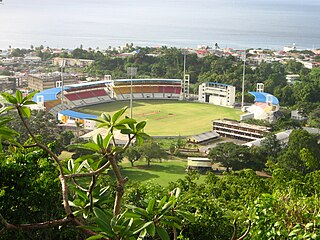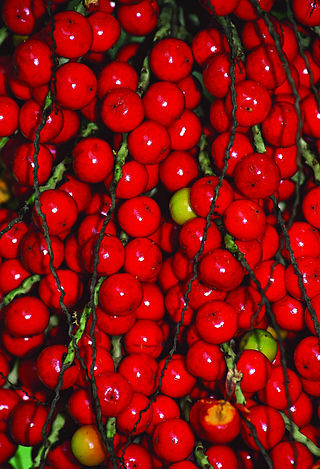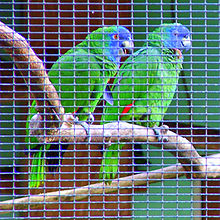
Roseau is the capital and largest city of Dominica, with a population of 16,571 as of 2023. It is a small and compact urban settlement, in the Saint George parish and surrounded by the Caribbean Sea, the Roseau River and Morne Bruce. Built on the site of the ancient Island Carib village of Sairi, it is the oldest and most important urban settlement on the island of Dominica.

The red-necked amazon, also known as the red-necked parrot, Dominican blue-faced amazon, lesser Dominican amazon, and jaco parrot or jaco, is an amazon parrot endemic to Dominica.

Windsor Park is a multi-purpose stadium in Roseau, Dominica. It serves as the country's national stadium and is used mostly for cricket and association football matches. Other uses have included the World Creole Music Festival, the Finals of the Calypso Competition and the Miss Dominica pageant.
Oliver James "O. J." Seraphin is a former Dominican politician. He served as the Minister of communication and works and housing for the Labour Party government from 1975–1979 and acting Prime Minister of Dominica from 25 June 1979 until 21 July 1980.
Dominica Broadcasting Corporation is the national radio station of the Commonwealth of Dominica. The service, owned by the local government, is headquartered on Victoria Street in the island's capital, Roseau. Broadcast on the 88.1 FM frequency, DBS' signal is also picked up across the Eastern Caribbean.

Wesley is a village in Saint Andrew Parish in north-eastern Dominica. It situated between the old estates of Eden and Londonderry and 1 1/2 miles southeast of Woodford Hill. Like many other villages along the east coast, Wesley developed after Emancipation on hilly land along the boundary between the two estates as labourers sought to establish independent holdings for themselves away from the plantations where they had formerly lived and worked.

Scotts Head is a village on the southwest coast of Dominica, in Saint Mark Parish. In 2001, its population was 721. Predominantly a fishing village, Scotts Head overlooks Soufrière Bay, which is protected as the Soufrière Scotts Head Marine Reserve. It is also a popular snorkeling and diving site for tourists.

Marigot is the largest settlement of Saint Andrew Parish in northeastern Dominica. The village has a population of 2,676 people, and is home to a Fisheries Complex as well as the island's main airport.

The Saint Vincent amazon, also known as Saint Vincent parrot, is a large, approximately 40 cm (16 in) long, multi-colored amazon parrot with a yellowish white, blue and green head, greenish-bronze upperparts plumage, and violet blue-green wings.

Aiphanes minima is a spiny palm tree which is native to the insular Caribbean from Hispaniola to Grenada, and widely cultivated elsewhere. Usually 5–8 metres (16–26 ft) tall, it sometimes grows as an understorey tree and only 2 m (6.6 ft) in height.

Calibishie is a village in Dominica, located on the north-east coast of the island, immediately to the east of the village of Hampstead. The Calibishie Coast Travel Area is thought by many to be the most scenic and unspoiled region of Dominica. The Calibishie coast is one of the few areas in the world where the distance from the seashore to rain forest is little more than a mile. Calibishie is home to Dominica's Batibou, Hampstead, Hodges, Point Baptiste, Turtle and Woodford Hill Beaches.

Dominica officially the Commonwealth of Dominica, is an island country in the Caribbean. The capital, Roseau, is located on the western side of the island. It is geographically situated as part of the Windward Islands chain in the Lesser Antilles archipelago in the Caribbean Sea. Dominica's closest neighbours are two constituent territories of the European Union, the overseas departments of France, Guadeloupe to the northwest and Martinique to the south-southeast. Dominica comprises a land area of 750 km2 (290 sq mi), and the highest point is Morne Diablotins, at 1,447 m (4,747 ft) in elevation. Its population was 71,293 at the 2011 census.

Anolis oculatus, the Dominica anole, Dominican anole, eyed anole or zandoli, is a species of anole lizard. It is endemic to the Caribbean island of Dominica, where it is found in most environments. The species is found in a diverse range of color forms, which one herpetologist once classified as four subspecies, which most other scientists did not recognise because the forms gradually inter-grade with one another. Two later researchers have instead promoted the "ecotypes" concept, hypothesizing the color forms are maintained by the ecological conditions of the surrounding environment, despite being genetically indistinguishable. The morphology of some traits is subject to clinal variation, gradually changing from one side of the island to the other, or from sea level to the hilltops. The ground color ranges from pale tan or yellow to deep green or brown. It also has patterned markings that range from light-colored speckling to complex marbled patterns, and some populations also have large black-ringed "eye" spots on their flanks.

The Dominican ground lizard or Dominican ameiva is a species of lizard. It is endemic to the Caribbean island of Dominica, an island noted for its intact and abundant reptile population, where it is most commonly found in dry coastal woodland.
Elma Napier, also known as Elma Gibbs and by the pen-name Elizabeth Garner, was a Scottish-born writer and politician who lived most of her life in the Caribbean island of Dominica. She published several novels and memoirs based on her life, and was the first woman elected to the legislature in Dominica.

The Kalinago Territory, previously known as the Carib Reserve or Carib Territory (outdated/derogatory), is a 3,700-acre (15 km2) district in the Caribbean island country of Dominica. It was established for the Indigenous Kalinago people who inhabited the region prior to European colonization and settlement.

Agostino Brunias was an Italian painter who was primarily active in the West Indies. Born in Rome around 1730, Brunias spent his early career as a painter after graduating from the Accademia di San Luca. After he befriended prominent Scottish architect Robert Adam and accompanied him back to Britain, Brunias left for the British West Indies to continue his career in painting under the tutelage of Sir William Young. Although he was primarily commissioned to paint the various planter families and their plantations in the West Indies, he also painted several scenes featuring free people of colour and cultural life in the West Indies. Brunias spent most of his West Indian career on the island of Dominica, where he would die in 1796. Historians have made disparate assessments of Brunias's works; some praised his subversive depiction of West Indian culture, while others claimed it romanticised the harshness of plantation life. Haitian revolutionary Toussaint Louverture was a prominent admirer of his work.
Princess Margaret Hospital is the major trauma facility of Dominica, located in the northern Goodwill part of the capital, Roseau, to the northeast of Lindo Park, north of the Dominica Botanical Gardens, southwest of Clifton Dupigny Technical College and south of Stock Farm Prison. There are approximately 15 house/resident doctors and 12 specialists. The hospital has a four-bed Intensive Care unit. A hyperbaric chamber exists, but is not operational. The Ambulance service is operated by the Fire Department, with approximately six ambulances. Princess Margaret is the main hospital on the island with 800 beds. Most of the building is old, although the French have constructed a new wing to help develop the hospital.
Belles is a small village in the Caribbean island nation of Dominica. It is located at 15°27′12.7″N61°19′11.4″W and is a part of the country's St. Joseph administrative division. Its population is 500. Belles is a historical site for a few reasons. It is a major part of the highway system to the northern part of the island. The roads were blocked many years ago by Rastafarians who were not happy with the government. Many of them escaped to Jaco Flats and used it for refuge. This is a site that was used by the Maroons hundreds of years ago. As of 2016, the Esprit and Benjamin families own and control a majority of the private land.

Morne Bruce is a hillside enclave located in Roseau, Dominica. It offers a panoramic view of the city and the Caribbean Sea beyond. The site was once home to the military garrison that protected Roseau. Remains of the original barracks and officers' quarters can still be seen today. One of the old cannons (non-operational) is still located at the site, near a giant cross that was erected in the 1920s. Morne Bruce is accessible by road or via Jack's Walk, a trail that begins in the Dominica Botanical Gardens.

















